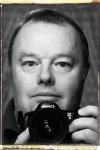
The Insatiable Energy of a Lightning Strike
Mount Stromlo Observatory, Canberra, Australia
17.40 / 24 September 2005
© 2005 Norman Peters, All Rights Reserved.
In the Australian Capital Territory (ACT) alone, the fire affected 164,914 hectares, caused major loss of private housing, infrastructure, softwood pine plantations and publicly owned facilities. The fires burnt about 70% of the ACT. This fire was one of a series of bushfires that burned almost four million hectares in south-eastern Australia, and caused an insured loss of well over A$250 million in the ACT alone. The real loss was incalculably greater.
At noon on the day of the fire, it was reported that the fire front was still about 20 kilometres away. Racing faster than anyone had calculated, the fire reached Mount Stromlo, the home of the Mount Stromlo Observatory, headquarters of the Research School of Astronomy & Astrophysics of the Australian National University, at about 3 o’clock in the afternoon. On the uphill western slope of Stromlo, the self-feeding firestorm was estimated to have reached a speed of 200 kilometres an hour. A friend of mine who worked in the observatory library later told me that the temperatures were somewhere between 1100 and 1400 degrees celcius, as two glass telescope mirrors with these metling points so faithfully testified – one melted, the other did not.
The observatory was described by the New Scientist magazine just after the fires to have been the source of a third of Australia's astronomical research. Six significant telescopes were completely destroyed. Instrumentation and engineering workshops, the observatory's library and the main administration buildings were also consumed by the fires. The insurance payment sought by the Australian National University, amounting to A$75 million, could become the largest claim in Australian history. The firestorm was a frightening experience – I live in Weston, which is just 5 kilometres to my house as the crow flies from Stromlo, and homes were lost just a couple of streets away from me. We could not see Stromlo burning as the entire afternoon sky was obliterated by dense black smoke.
The panorama opens showing the western slope of Stromlo, up which the fires raced. Before the fire, this landscape was home to a vast pine plantation, now all destroyed. The trees in the foreground are eucalypts that can survive bushfires, but which are still showing the effects of the fire some 33 months later.
To the east from here is the gutted Heliostat and the Commonwealth Solar Observatory building, showing the wrecked domes. To the south is the remains of the 30 inch Reynolds reflector building. Turning to the north you can see the remains of the 50 inch reflector telecsope building, and the wreckage of the scope is still visible through the doorway and above the existing roofline in the absence of the protective roof dome. This was formerly the Great Melbourne Telescope (GMT), built by Grubb of Dublin in 1868 for the Melbourne Observatory. At the time, it was the largest fully-steerable telescope in the world, and up to the early 1950s it was the largest telescope in the southern hemisphere
You can make out the white dome of the satellite laser rangefinder observatory operated by Electro Optic Systems that was quickly rebuilt and is again fully operational, slightly to the north west in the distance.
Through the energies of staff and supporters, Stromlo will live again.
Australia - New Zealand / Australia
Lat: 36° 20' 13" S
Long: 149° 0' 25" E
Elevation: 768 metres
Precision is: Unknown / Undeclared.
_ _ _ _ _ _ _ _ _ _ _ _ _
|_ _ _ _ _ _ _ _ _ _ _ _ _ | top row – 1 image
|_|_|_|_|_|_|_|_|_|_|_|_|_|_| second row – 14 images
|_|_|_|_|_|_|_|_|_|_|_|_|_|_| middle row – 14 images
|_|_|_|_|_|_|_|_|_|_|_|_|_|_| fourth row – 14 images
|_ _ _ _ _ _ _ _ _ _ _ _ _ | bottom row – 1 image
The images were shot on a tripod-mounted Canon 10D digital SLR, fitted with a hacked Canon 18-55 mm EF-S zoom set at 18 mm. The exposure was manually set, as was the focus. The RAW iamges were converted in Photoshop to smaller resolution TIFFs, and stitched together with PTGUI 4.1 as the frontend to Panotools. The cubic QTVR conversion was handled by PanoCubePro. All processes were run under Windows XP SP2, on an Athlon XP 3200+ processor with 2 Gb RAM. To complicate processing further, I managed to forget to take along a spirit level, and so I had to adjust the horizon during the stitching processing to make it appear level. The zenith and nadir images were edited with Photoshop after being output by PanoCubePro.


 Tap or click the zoom icon in the bottom right corner of the picture to switch between in-page and fullscreen view
Tap or click the zoom icon in the bottom right corner of the picture to switch between in-page and fullscreen view